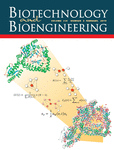|
Autors/es
Martínez‐Monge, I.; Albiol, J.; Lecina, M. ; Liste‐Calleja, L.; Miret, J.; Solà, C.; Cairó, J. J. ; Liste‐Calleja, L.; Miret, J.; Solà, C.; Cairó, J. J.
|
Abstract
At early stages of the exponential growth phase in HEK293 cell cultures, the tricarboxylic acid cycle is unable to process all the amount of NADH generated in the glycolysis pathway, being lactate the main by‐product. However, HEK293 cells are also able to metabolize lactate depending on the environmental conditions. It has been recently observed that one of the most important modes of lactate metabolization is the cometabolism of lactate and glucose, observed even during the exponential growth phase. Extracellular lactate concentration and pH appear to be the key factors triggering the metabolic shift from glucose consumption and lactate production to lactate and glucose concomitant consumption. The hypothesis proposed for triggering this metabolic shift to lactate and glucose concomitant consumption is that HEK293 cells metabolize extracellular lactate as a response to both extracellular protons and lactate accumulation, by means of cotransporting them (extracellular protons and lactate) into the cytosol. At this point, there exists a considerable controversy about how lactate reaches the mitochondrial matrix: the first hypothesis proposes that lactate is converted into pyruvate in the cytosol, and afterward, pyruvate enters into the mitochondria; the second alternative considers that lactate enters first into the mitochondria, and then, is converted into pyruvate. In this study, lactate transport and metabolization into mitochondria is shown to be feasible, as evidenced by means of respirometry tests with isolated active mitochondria, including the depletion of lactate concentration of the respirometry assay. Although the capability of lactate metabolization by isolated mitochondria is demonstrated, the possibility of lactate being converted into pyruvate in the cytosol cannot be excluded from the discussion. For this reason, the calculation of the metabolic fluxes for an HEK293 cell line was performed for the different metabolic phases observed in batch cultures under pH controlled and noncontrolled conditions, considering both hypotheses. The main objective of this study is to evaluate the redistribution of cellular metabolism and compare the differences or similarities between the phases before and after the metabolic shift of HEK293 cells (shift observed when pH is not controlled). That is from a glucose consumption/lactate production phase to a glucose‐lactate coconsumption phase. Interestingly, switching to a glucose and lactate cometabolization results in a better‐balanced cell metabolism, with decreased glucose and amino acids uptake rates, affecting minimally cell growth. This behavior could be applied to further develop new approaches in terms of cell engineering and to develop improved cell culture strategies in the field of animal cell technology.
|

WoS
Scopus
Altmetrics
  
|
